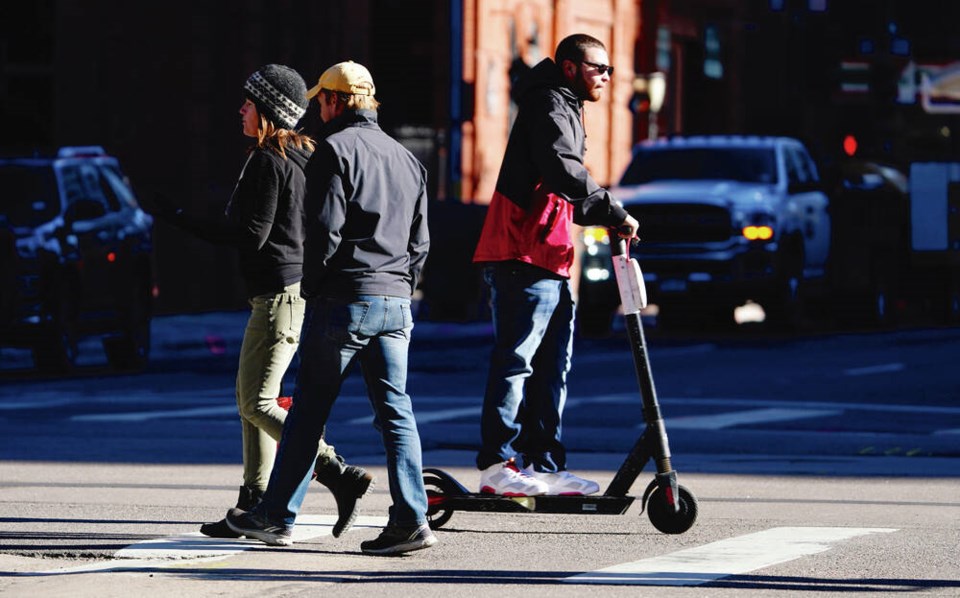A friend made a good point the other day about how fast technological innovations are starting to appear in our lives. His main issue, in regard to traffic safety, was that “things” are developed, marketed and sold so quickly now that the law can’t keep up.
It’s a good point.
Let’s take a couple of examples. Pretty much every day I see a small but noticeable eclectic array of new devices whizzing people around like scenes from the Jetsons.
Known as electric kick scooters, electric unicycles, one wheelers or hoverboards, they’re the latest in that wave of innovations intended to appeal to both recreationalists and to those who don’t want to walk but who also don’t want to cycle or drive.
They’re an ideal option for those who are limber enough to balance and manoeuvre them around. They’re easy to store, recharge and emission free.
However, there are a lot of “buts” in this revolution, as we figure out how the rest of the driving and cycling world will safely coexist with these gizmos. The law, unfortunately, struggles here.
The basic rule, for now at least, is that electric scooters and the like are illegal to operate anywhere in B.C. except on private property.
But like every good rule, there are exceptions. A pilot project allows several municipalities in B.C. to test out the effects of electric kick scooters: Kelowna; Nanaimo; Vernon; Richmond; Vancouver; and the districts of North and West Vancouver.
All of these districts are required to enact by-laws permitting their use and then make a report annually to the government about their experiences. I’ll be interested to know what they learn.
The rules are, in fact, pretty comprehensive under B.C.’s electric kick scooter pilot project regulation, enacted in March of last year. But for me there are still some big concerns.
I’ve preached this one a few times before in relation to dazzle headlights and modified exhaust pipes on motorcycles: Why are they allowed to be sold in places where they can’t be legally used?
A person gains a certain “implied licence” to operate illegal equipment when they can purchase it from a legally operating seller. It’s the wrong message.
There are further problems with electric scooters specifically, but they also apply to all these new electric conveyances.
B.C. law requires an electric scooter or its rider to have lights, front and rear, after dark. But factory equipped rear lights on some scooters are mounted barely a foot high from the road and difficult to spot from vehicles approaching from behind.
Their wheels are inadequate for most road or sidewalk obstructions. Don’t know if you’ve noticed but there’s a fair amount of road construction around here and throughout the province these days and I couldn’t grade the general condition of our roads better than a “C+”.
Several scooters have pneumatic tires with tread and offer some ability to handle bumps but others offer only hard plastic wheels which are way more vulnerable to cracks, potholes and liquid spills.
One scooter safety advocate calculated that a scooter wheel requires 50% more force than a bicycle wheel to mount an obstruction just one inch high. Studies in the U.K. show that the minimum size wheel necessary to overcome most typical road obstructions is 16 inches — far larger than the ones I’ve seen around here lately.
Electric unicycles and one-wheeled hoverboards are a little more grey. Their absence from any special category or definition in B.C. law means they meet the literal definition of a motor vehicle — which then can’t be ridden in a bike lane or a sidewalk. As they have none of the required lights or other safety features required in vehicles, they can’t be operated on a highway either.
Yet you can find numerous websites throughout B.C. and beyond offering these latter two devices for sale. One retail website offers a pseudo disclaimer, stating they know they’re kinda sorta not legal, but hey, they’re “green” and getting more and more popular, so buy one anyway.
Remember, they’re classified as motor vehicles currently and motor vehicles in B.C. are required to be insured. The fine for not having insurance is $598, so I would be thinking way past vague disclaimers offered by any retailer.
We are all looking for green alternatives now. But devices that are far less visible, too fast for sidewalks and too slow for roadways need much more careful legal consideration.
We’re making a big mistake if we over-prioritize being green or the convenience these machines may offer as an excuse to minimize user safety and the effects they have on other road users.



